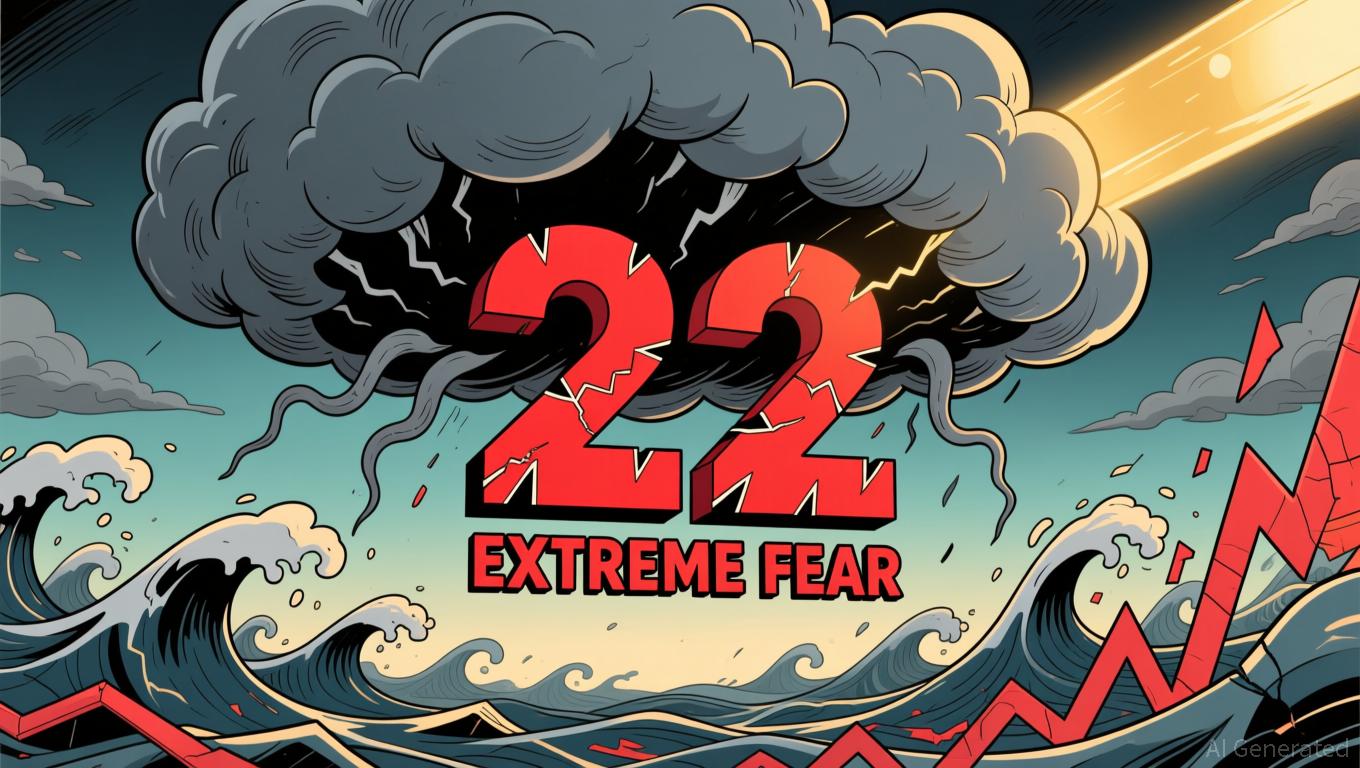Bitcoin News Update: Bitcoin Fear Index Drops to 22 While Investors Look for Signs of Market Rebound
- Bitcoin Fear & Greed Index rose to 22 from 20, indicating slight easing of extreme fear but persistent bearish sentiment. - Bitcoin stabilized near $87,000 after hitting $80,553, yet remains below key resistance levels amid $3.5B ETF outflows. - Structural factors like leverage and liquidations drive selloffs, with ETF redemptions correlating to 3.4% price drops per $1B outflow. - Analysts note oversold technical indicators and waning retail capitulation as potential inflection points for near-term rebou
Bitcoin Market Sentiment Shows Slight Improvement
The Bitcoin Fear & Greed Index has risen to 22, indicating a modest reduction in market anxiety compared to recent lows, though overall sentiment remains strongly negative. This uptick from 20 the previous day suggests a tentative move toward stability, as traders continue to navigate ongoing volatility. The index, which compiles data from market volatility, trading volume, and social media trends, now sits just above the "extreme fear" mark of 20. While panic has eased somewhat, investor caution still dominates, as highlighted by recent analyses.
Bitcoin Price Stabilizes After Recent Lows
Despite the slight improvement in sentiment, the broader cryptocurrency market continues to face challenges. Bitcoin, which recently dropped to a seven-month low of $80,553, has managed to recover and is now trading near $87,000, according to Bloomberg. However, the asset remains in a bearish trend, with significant resistance levels at $90,500 and $100,000 serving as important indicators for a potential reversal. Analysts point out that extended periods of extreme fear—such as the current week-long stretch—have historically preceded market bottoms, as selling pressure fades and contrarian investors begin to step in, as noted by CoinDesk.

Structural Factors Intensify Market Downturn
Underlying market mechanics, such as leverage and forced liquidations, have contributed to the recent decline. A recent discussion on X emphasized that the correction in both digital assets and traditional markets has been driven by structural dynamics rather than specific news events, with leveraged positions accelerating the downward trend, according to Cointelegraph. This is reflected in Bitcoin ETFs, which are experiencing their largest monthly outflows since launch, with $3.5 billion withdrawn in November alone. BlackRock's IBIT, the largest Bitcoin ETF, has seen $2.2 billion in redemptions, as reported by Bloomberg. Citi Research estimates that for every $1 billion in ETF outflows, Bitcoin’s price drops by approximately 3.4%, highlighting the strong link between institutional flows and market sentiment.
Signs of Possible Rebound Amid Cautious Optimism
Despite prevailing pessimism, some market observers anticipate a potential short-term recovery. The Fear & Greed Index’s climb to 22 coincides with Bitcoin reclaiming the $90,000 level, which has often served as a psychological support. Data from Santiment shows that social media sentiment is at its lowest since late 2023, according to Cointelegraph, possibly indicating that retail selling is tapering off. Technical indicators such as the RSI and MACD suggest the market may be approaching oversold conditions, with the RSI nearing 30 and the MACD histogram leveling out, signaling possible indecision among traders, as noted by Forex.com.
Altcoins and Regulatory Concerns Add to Market Pressure
The overall crypto market remains unstable, with altcoins underperforming Bitcoin due to limited liquidity, according to CoinDesk. Additional uncertainty has been introduced by Tether’s CEO, who has recently been at odds with S&P Global Ratings, which now includes a 5.6% allocation to Bitcoin. Ongoing regulatory scrutiny, combined with the Federal Reserve’s postponement of expected rate cuts, continues to weigh on risk assets.
Outlook: Awaiting a Clear Catalyst for Recovery
Looking forward, the market’s recovery will depend on whether institutional investment stabilizes and if new macroeconomic drivers emerge. While the current Fear & Greed Index readings suggest a potential market bottom, history indicates that a significant catalyst—such as regulatory clarity, favorable economic developments, or renewed retail interest—is often required to spark a lasting rebound, as CoinDesk reports. For now, traders remain cautious, closely monitoring the index and Bitcoin’s ability to maintain support above $80,300 as key factors in determining the next stage of this volatile market.
Disclaimer: The content of this article solely reflects the author's opinion and does not represent the platform in any capacity. This article is not intended to serve as a reference for making investment decisions.
You may also like
Trump's cryptocurrency empire faces allegations of boosting political sway and posing security risks
- House Democrats accuse Trump's WLFI crypto firm of selling tokens to sanctioned entities like North Korea and Russia, calling it the "world's most corrupt crypto startup." - The firm's $1B in crypto profits and ties to the Trump brand raise national security concerns over political influence and illicit financial activity. - Eric Trump stepped back from WLFI operations in September amid regulatory scrutiny, highlighting conflicts of interest and insider trading risks. - The case underscores broader crypt

South Korea Revamps Cryptocurrency Regulations to Tackle Crime and Strengthen Digital Economy Leadership
- South Korea's Financial Intelligence Unit plans stricter AML measures, including pre-emptive account freezes, to combat crypto crimes by mid-2026. - A $30M Upbit hack linked to North Korea's Lazarus group highlights vulnerabilities, prompting enhanced exchange security protocols and loss coverage pledges. - Terra co-founder Do Kwon faces up to 40 years in South Korea for the $40B crypto crash, reflecting global accountability trends after FTX's collapse. - Regulators push for bank-led stablecoin issuance

Hong Kong’s SFC Approves Hang Feng’s Expansion into Virtual Assets
- Hang Feng's subsidiary HFIAM secured Hong Kong SFC approval to offer virtual asset advisory and management services, expanding its licensed scope to include digital assets. - The upgraded licenses enable HFIAM to manage portfolios with over 10% virtual asset exposure and launch standalone crypto funds, aligning with Hong Kong's innovation-focused regulatory framework. - This strategic move positions Hang Feng to capitalize on institutional demand for digital assets while emphasizing compliance, transpare

Opportunities in Webster, NY: Capitalizing on Infrastructure Funding and Redevelopment Prospects
- Webster , NY, leverages $9.8M FAST NY grants to upgrade infrastructure at a 300-acre brownfield, attracting advanced manufacturing and logistics firms like fairlife®. - Redevelopment of the former Xerox Wilson Campus aims to create 250 jobs by 2025, supported by $650M in reconfiguration and state-backed industrial expansion initiatives. - Parallel urban revitalization at 600 Ridge Road targets mixed-use development, boosting property values and tax revenues while addressing blighted properties in West We
